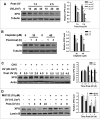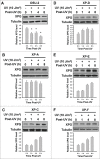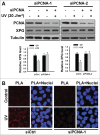Cdt2-mediated XPG degradation promotes gap-filling DNA synthesis in nucleotide excision repair
- PMID: 25483071
- PMCID: PMC4614405
- DOI: 10.4161/15384101.2014.973740
Cdt2-mediated XPG degradation promotes gap-filling DNA synthesis in nucleotide excision repair
Abstract
Xeroderma pigmentosum group G (XPG) protein is a structure-specific repair endonuclease, which cleaves DNA strands on the 3' side of the DNA damage during nucleotide excision repair (NER). XPG also plays a crucial role in initiating DNA repair synthesis through recruitment of PCNA to the repair sites. However, the fate of XPG protein subsequent to the excision of DNA damage has remained unresolved. Here, we show that XPG, following its action on bulky lesions resulting from exposures to UV irradiation and cisplatin, is subjected to proteasome-mediated proteolytic degradation. Productive NER processing is required for XPG degradation as both UV and cisplatin treatment-induced XPG degradation is compromised in NER-deficient XP-A, XP-B, XP-C, and XP-F cells. In addition, the NER-related XPG degradation requires Cdt2, a component of an E3 ubiquitin ligase, CRL4(Cdt2). Micropore local UV irradiation and in situ Proximity Ligation assays demonstrated that Cdt2 is recruited to the UV-damage sites and interacts with XPG in the presence of PCNA. Importantly, Cdt2-mediated XPG degradation is crucial to the subsequent recruitment of DNA polymerase δ and DNA repair synthesis. Collectively, our data support the idea of PCNA recruitment to damage sites which occurs in conjunction with XPG, recognition of the PCNA-bound XPG by CRL4(Cdt2) for specific ubiquitylation and finally the protein degradation. In essence, XPG elimination from DNA damage sites clears the chromatin space needed for the subsequent recruitment of DNA polymerase δ to the damage site and completion of gap-filling DNA synthesis during the final stage of NER.
Keywords: CRL4; Cdt2; PCNA; XPG; gap-filling DNA synthesis; nucleotide excision repair; protein degradation; ubiquitylation.
Figures






Similar articles
-
Proliferating cell nuclear antigen interacts with the CRL4 ubiquitin ligase subunit CDT2 in DNA synthesis-induced degradation of CDT1.J Biol Chem. 2018 Dec 7;293(49):18879-18889. doi: 10.1074/jbc.RA118.003049. Epub 2018 Oct 9. J Biol Chem. 2018. PMID: 30301766 Free PMC article.
-
CRL4(Cdt2) E3 ubiquitin ligase monoubiquitinates PCNA to promote translesion DNA synthesis.Mol Cell. 2010 Jan 15;37(1):143-9. doi: 10.1016/j.molcel.2009.12.018. Mol Cell. 2010. PMID: 20129063 Free PMC article.
-
Mismatch repair proteins recruited to ultraviolet light-damaged sites lead to degradation of licensing factor Cdt1 in the G1 phase.Cell Cycle. 2017 Apr 3;16(7):673-684. doi: 10.1080/15384101.2017.1295179. Epub 2017 Feb 22. Cell Cycle. 2017. PMID: 28278049 Free PMC article.
-
PCNA-coupled p21 degradation after DNA damage: The exception that confirms the rule?DNA Repair (Amst). 2010 Apr 4;9(4):358-64. doi: 10.1016/j.dnarep.2009.12.003. Epub 2010 Jan 8. DNA Repair (Amst). 2010. PMID: 20060369 Free PMC article. Review.
-
Mechanism of CRL4(Cdt2), a PCNA-dependent E3 ubiquitin ligase.Genes Dev. 2011 Aug 1;25(15):1568-82. doi: 10.1101/gad.2068611. Genes Dev. 2011. PMID: 21828267 Free PMC article. Review.
Cited by
-
CRL4Cdt2 ubiquitin ligase regulates Dna2 and Rad16 (XPF) nucleases by targeting Pxd1 for degradation.PLoS Genet. 2020 Jul 21;16(7):e1008933. doi: 10.1371/journal.pgen.1008933. eCollection 2020 Jul. PLoS Genet. 2020. PMID: 32692737 Free PMC article.
-
PostExcision Events in Human Nucleotide Excision Repair.Photochem Photobiol. 2017 Jan;93(1):178-191. doi: 10.1111/php.12641. Epub 2016 Oct 27. Photochem Photobiol. 2017. PMID: 27645806 Free PMC article. Review.
-
The emerging role for Cullin 4 family of E3 ligases in tumorigenesis.Biochim Biophys Acta Rev Cancer. 2019 Jan;1871(1):138-159. doi: 10.1016/j.bbcan.2018.11.007. Epub 2018 Dec 30. Biochim Biophys Acta Rev Cancer. 2019. PMID: 30602127 Free PMC article. Review.
-
Direct binding of Cdt2 to PCNA is important for targeting the CRL4Cdt2 E3 ligase activity to Cdt1.Life Sci Alliance. 2018 Dec 31;1(6):e201800238. doi: 10.26508/lsa.201800238. eCollection 2018 Dec. Life Sci Alliance. 2018. PMID: 30623174 Free PMC article.
-
Emerging Roles of Post-Translational Modifications in Nucleotide Excision Repair.Cells. 2020 Jun 15;9(6):1466. doi: 10.3390/cells9061466. Cells. 2020. PMID: 32549338 Free PMC article. Review.
References
-
- Gillet LC, Scharer OD. Molecular mechanisms of mammalian global genome nucleotide excision repair. Chem Rev 2006; 106:253-76; PMID:16464005; http://dx.doi.org/10.1021/cr040483f - DOI - PubMed
-
- Kamileri I, Karakasilioti I, Garinis GA. Nucleotide excision repair: new tricks with old bricks. Trends Genet 2012; 28:566-73; PMID:22824526; http://dx.doi.org/10.1016/j.tig.2012.06.004 - DOI - PubMed
-
- Mu D, Park C-H, Matsunaga T, Hsu DS, Reardon JT, Sancar A. Reconstitution of human DNA repair excision nuclease in a highly defined system. J Biol Chem 1995; 270:2415-8; PMID:7852297; http://dx.doi.org/10.1074/jbc.270.6.2415 - DOI - PubMed
-
- Araujo SJ, Tirode F, Coin F, Pospiech H, Syvaoja JE, Stucki M, Hubscher U, Egly JM, Wood RD. Nucleotide excision repair of DNA with recombinant human proteins: definition of the minimal set of factors, active forms of TFIIH, and modulation by CAK. Genes Dev 2000; 14:349-59; PMID:10673506 - PMC - PubMed
-
- Volker M, Mone MJ, Karmakar P, Van Hoffen A, Schul W, Vermeulen W, Hoeijmakers JH, van Driel R, Van Zeeland AA, Mullenders LH. Sequential assembly of the nucleotide excision repair factors in vivo. Mol Cell 2001; 8:213-24; PMID:11511374; http://dx.doi.org/10.1016/S1097-2765(01)00281-7 - DOI - PubMed
Publication types
MeSH terms
Substances
Grants and funding
LinkOut - more resources
Full Text Sources
Other Literature Sources
Miscellaneous
